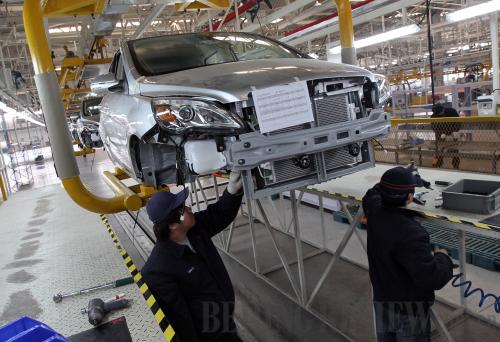|
 |
|
CLEAN CARS: Engineers work on electric vehicles at the Beijing New Energy Automotive Co. on November 7 (CFP) |
To ensure the long-term fund, developing countries said at the Doha conference that they need at least $60 billion from 2013 to 2015 to deal with droughts, floods, rising seas and storms caused by climate change.
"We know that the United States and the EU are facing financial difficulties, so we propose the mid-term fund," Xie said. "They should give a clear answer."
Connie Hedegaard, EU Commissioner for Climate Action, said EU donors who are willing to continue giving money are also willing to give in the short term.
But in order to scale up to $100 billion a year, there is no way but through public money, said Hedegaard. The EU needs time to find out how they can leverage private financing through public money, or secure more private sources.
Stern said the United States will continue the long-term goal of mobilizing funding by 2020 in the context of mitigation and transparency.
While some developed countries agreed to continue providing money, whether mid-term or long-term, developing countries are still in doubt.
"When it comes to political statements, developed countries are ready to support, but in terms of figures, they are not fulfilling their commitments," said Larbi Djacta, Minister Counselor in charge of G77 of the Permanent Mission of Algeria to the United Nations. G77 is the largest intergovernmental organization of developing countries in the United Nations, in which Algeria currently holds the chairmanship position.
"The only thing developed countries have to do now is to fulfill their commitments, and the means of implementation is our biggest concern," said Djacta.
The means of implementation, according to Djacta, refers to supporting developing countries financially, helping them in technology and enhancing their capacities, which could make it possible for them to adapt to the challenge of climate change and enable their capacities to face the adverse impact of climate change.
"We obviously need financial assistance, capacity building and technological assistance," said Dr. Mariyam Shakeela, Minister of Environment and Energy of the Republic of Maldives. The country is one of the small island states that are most vulnerable to climate changes.
"Our infrastructure was not built to adapt and we need climate-resilient methods to build communities," said Shakeela. "So we need the money and technology."
But achieving a balanced result also means that China hopes that all previously agreed upon commitments before 2020 should be implemented, said Xie, head of the Chinese delegation.
On the basis of this result, China will provide and has provided some money to help developing countries through South-South cooperation, he said.
Facing a dilemma
While China has emerged as the world's second largest economy, it has become the world's largest carbon dioxide emitter, and its per-capita emission is around the world's average level.
"In tackling climate change and seeking sustainable development, China is facing enormous challenges," said Xie.
'We're not surprised that emissions are rising significantly in China," said Hedegaard. "Latest statistics we've seen show that actual emission levels are growing even more than its GDP is growing."
The challenge for China is to try to decouple economic growth and growth in emissions, she said.
A country's emission level will increase in tandem with economic growth, but when emission peaks, the level will remain stable for a period and then begin to drop, said Xie. It resembles an inverted U-shaped curve.
Developed countries' emissions stopped increasing when their per-capita GDP reached $40,000-50,000, said Xie. "But China's per-capita GDP is only about $5,000 and China's emission is at the climbing stage."
However, with efforts, China's emission can peak when its per-capita GDP is only half of the developed countries' peak level, he said.
| 